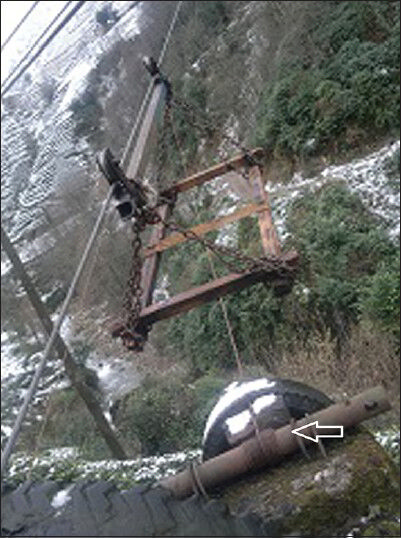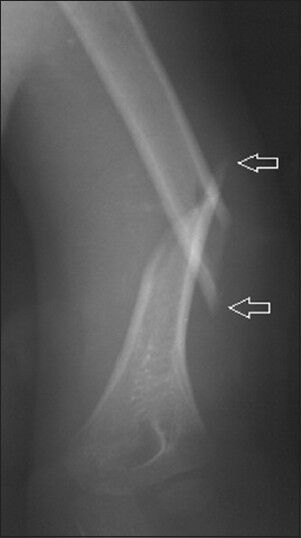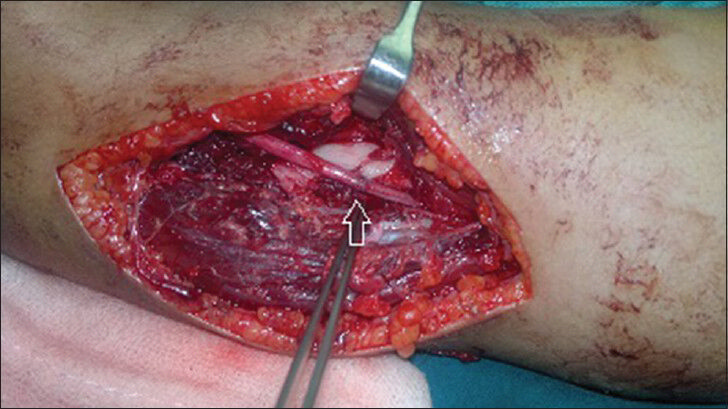Translate this page into:
Difficulty in Clinical Evaluation of Radial Nerve Injury due to Multiple Trauma to the Humerus, Wrist, and Hand
Address for correspondence: Assist. Prof. Balık Mehmet Sabri, Department of Orthopaedic and Traumatology, Medical Faculty, Recep Tayyip Erdoğan University, Islampaşa Mahallesi, Sehitler Caddesi, No: 74, 53100 Rize, Turkey. E-mail: sabribalik@yahoo.com
-
Received: ,
Accepted: ,
This is an open-access article distributed under the terms of the Creative Commons Attribution License, which permits unrestricted use, distribution, and reproduction in any medium, provided the original author and source are credited.
This article was originally published by Medknow Publications & Media Pvt Ltd and was migrated to Scientific Scholar after the change of Publisher.
Abstract
Radial nerve damage is frequently encountered in humeral fractures. The radial nerve is primarily damaged when the humerus gets fractured, while secondary damage maybe due to post-traumatic manipulations and surgical exploration. High impact traumatic nerve injury, serious neuropathic pain, lack of response to therapeutic interventions, and indifference to the Tinel test are indications for surgical intervention. Since most humeral fracture-induced low impact radial nerve injuries resolve spontaneously, conservative therapy is preferred. We present a patient with humeral fracture-associated radial nerve injury, accompanied with digital amputation and flexor tendon avulsion on the same arm. These injuries required immediate surgery, thus rendering the clinical evaluation of the radial nerve impossible. We would like to highlight and discuss the inherent difficulties associated with multiple trauma of the upper arm.
Keywords
Arm injury
humeral fracture
radial nerve lesion
INTRODUCTION

Radial nerve injury is among the peripheral nerve lesions sustained from the fractures of the long bones.[1] It occurs in 1 out of 10 humeral fractures.[23] Radial nerve injury as a result of humeral fracture can be primary or secondary. The primary damage occurs as a result of trauma and the secondary damage results from post-traumatic manipulations and surgery.[45]
We present a case of a 5-year-old boy who sustained a crush injury resulting in humeral fracture-associated radial nerve damage, along with amputation of digits and flexor tendon avulsion on the left arm and hand. These injuries required immediate surgery, making it impossible to clinically evaluate the radial nerve injury. We would like to highlight and discuss the inherent difficulties associated with multiple trauma of the upper extremity.
CASE REPORT
A five-year-old patient presented to the orthopaedic outpatient department with a crush injury to the left upper arm. According to witnesses, pulling cable of a haulage cable car coiled around the patient's left wrist, elbow, and shoulder [Figure 1]. The cable amputated the distal phalanx of the 3rd digit, and detached the flexor digitorum profundus tendon of the 3rd digit, and caused a spiral fracture of the humerus [Figure 2]. The left wrist and hand were unable to actively extend. We were unable to establish the cause of the loss of extension of the hand and fingers. It could have been due to damage to the radial nerve or damage to the hand and forearm.

- Five-year old boy with a crush injury extending from his shoulder to the distal part of his left arm. The injury was sustained by the curling of the affected arm around the pulling cable of a haulage cable car (arrow).

- Five-year old boy with a crush injury extending from his shoulder to the distal part of his left arm. X-ray shows spiral fracture of the distal diaphysis of the left humerus (arrows).
The alignment of humerus was not aceptable. Since the humerus fracture line crossed the anatomical trace of the radial nerve, no manipulation was applied. Because of the hand and forearm injuries effective sensory-motor assessment of the radial nerve could not performed. We preferred surgical intervention instead of closed reduction. The patient was taken to the emergency operating room, where we performed tenodesis of the flexor digitorum profundus tendon, and covered the amputation stub. During surgery, the humerus was accessed by lateral incision. The radial nerve was discontinuous (neurotmesis) [Figure 3]. Following proper reduction of the humerus, intramedullary fixation was applied [Figure 4]. The radial nerve was repaired by microsurgery [Figure 5]. Following long arm splint, the patient was discharged with oral analgesics and antibiotics. In the 3rd week after the operation, a range of motion exercises were initiated. The splint that was keeping the fingers flexed was removed 6 weeks after the operation.

- Five-year old boy with a crush injury extending from his shoulder to the distal part of his left arm. Photograph of the nerve after lateral incision shows the cut radial nerve (arrow).

- Five-year old boy with a crush injury extending from his shoulder to the distal part of his left arm. X-ray shows proper reduction (arrow a) and intramedullary fixation (arrow b) of the humeral diaphysis.

- Five-year old boy with a crush injury extending from his shoulder to the distal part of his left arm. Photograph shows radial nerve (arrow) repaired by microsurgery.
Postoperatively, the function of the radial nerve was followed by electromyography and physical examination such as the Tinel sign. The affected wrist and digits regained full extension six months after the operation [Figure 6].

- Five-year old boy with a crush injury extending from his shoulder to the distal part of his left arm. Photograph of the arm and wrist six-months after the opeartion shows the affected wrist and digits of the patient had regained full extension.
DISCUSSION
Radial nerve injury are frequent in one out three humeral, medial, and distal fractures.[67] The chief reason for radial nerve damage is the anatomic proximity of the nerve to the center and distal parts of the humerus. Nerve damage is more common in the short, oblique, and spiral fractures of the humerus.[58] Fracture fragments can damage the radial nerve directly, the nerve can become trapped by the intrusion of the intermuscular septum into the fragments, and the nerve can be stretched by the angulation of the fragments.[68] According to the Seddon Classification, partial or complete spontaneous recovery occurs in peripheral nerve injuries of the neuropraxia and axonotmesis types.[9]
Cases of high impact traumatic nerve injuries, serious neuropathic pain, lack of response to therapeutic interventions, and indifference to the Tinel test constitute indicators for surgical intervention.[1] As most humeral fracture-induced low impact primary radial nerve damages resolve spontaneously,[14] conservative therapy is the preferred option.[245]
The fracture in our case was localized in the diaphysis of humerus. The fracture was spiral and its ends were angular. The injury was a high impact injury. These features were predisposing factors for radial nerve damage. To confirm damage to the radial nerve, proper assessment of the nerve was required. Because of the involvement of the fingers and forearm in the injury, radial nevre function could not be evaluated. The forearm was fixed to the neck at 90 flexion, thereby leaving the elbow hanging free. Radiologic examination in this position revealed misalignment of the humerus and soft tissue-displaced fracture ends. For these reasons, manipulation of the fracture was avoided, and we planned exploration of the radial nerve and reductive operation of the fracture.
CONCLUSION
In radial nerve damages sustained from high impact injuries, or over-angulation or “drift” of humeral fractures, which are accompanied by additional injuries that hinder early clinical evaluation of the radial nerve, priority maybe given to surgical intervention.
Available FREE in open access from: http://www.clinicalimagingscience.org/text.asp?2014/4/1/16/129263
Source of Support: This article was presented in National Emergency Medicine Congress in 2011
Conflict of Interest: None declared.
REFERENCES
- Radial nerve palsy associated with fractures of the shaft of the humerus: A systematic review. J Bone Joint Surg Br. 2005;87:1647-52.
- [Google Scholar]
- Radial nerve palsy associated with humeral shaft fracture: Evaluation with US-initial experience. Radiology. 2001;219:811-6.
- [Google Scholar]
- Peripheral nerve injuries associated with fractures and dislocations. In: Gelberman RH, ed. Operative Nerve Repair and Reconstruction. Philedelphia: JB Lippincott; 1991. p. :619-21.
- [Google Scholar]
- Radial-nerve paralysis associated with fractures of the humerus. A review of forty-five cases. J Bone Joint Surg Am. 1967;49:899-902.
- [Google Scholar]
- Radial nerve injuries associated with humeral fractures. J Hand Surg Am. 2006;31:655-63.
- [Google Scholar]
- Fractures of the humerus with radial nevre paralysis. J Bone Joint Surg Am. 1963;45:1382-8.
- [Google Scholar]
- Fractures of the humeral shaft: A retrospective study of 240 adult fractures. Clin Orthop Relat Res. 1975;112:254-62.
- [Google Scholar]
- Outcomes of nervereconstruction for radial nerve injuries based on the level of injury in 244 operative cases. J Hand Surg Eur. 2010;35:385-91.
- [Google Scholar]
- Peripheral nerve palsies associated with closed fractures and dislocations. Injury. 2006;37:507-12.
- [Google Scholar]






